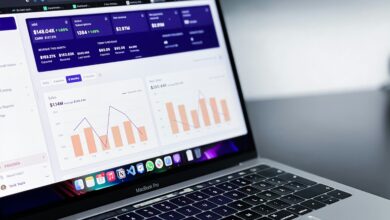How AI, ML, and Embedded Analytics Bring Success?

Jay Allardyce, GM of data and analytics at Insight Software, explores the challenges and opportunities presented by the abundance of data, emphasizing the importance of leveraging AI and machine learning to extract valuable insights.
The amount of data we produce daily is outstanding. That pace is only accelerating in the years to come with the growth of innovations such as artificial intelligence (AI) and machine learning (ML).
In fact, as Rachel Galvez of Precisely reported, 77% of data and analytics professionals cite data-driven decision-making as the leading goal of their data programs – but unfortunately, only 46% have “high” or “very high” trust in the data used for decision-making.
Organizations that can effectively leverage data as a strategic asset will inevitably build a competitive advantage and outperform their peers over the long term. However, it’s a double-edged sword. Poor data quality can cost organizations in the long run if not a priority. 70% of professionals who struggle to trust their data claim that data quality is the biggest issue.
For organizations to effectively harness the power of data and succeed within their environment, they must understand why better data storytelling is necessary, the difference between predictive-versus-augmented analytics, and how to best apply predictive analytics. According to a recent report, as many as 94% of business leaders feel their organization should be getting more value from its data.
Fortunately, embedding such analytics into an organization’s current web-based applications brings a new level of experience and engagement. The results are threefold: (i) different ‘actionable signals’ to users, (ii) leveraging an existing experience they are used to, and (iii) focusing on the use case for the necessary job to be done (JTBD). Users don’t need another tool; they need a more enhanced experience to get their job done – faster.
Decision-making With Data Storytelling
Embedded analytics is a sector that’s still experiencing a wave of innovation, enhancing the traditional operating reports and dashboards we know to become experiences that are more adaptive and responsive to business conditions.
Even though this concept of data storytelling is still new and evolving, fully understanding the benefits is essential, and furthering the investments to advance a company’s data culture to understand how best to work with data is essential.
By embedding a layer of analytics into an application, organizations will pave the way to delivering greater data experiences that lead to stronger user engagement and promote a strong data culture, foundational to becoming more data-driven and data-decision-oriented. Ultimately, this essentially delivers better data-driven product experiences.
For example, operating and product teams specifically can stay ahead of the curve by simplifying data preparation and visualization for decision-making while optimizing applications to gain insights from near-real-time data, visualizations, interactive reports, and other capabilities. Not to mention, it saves time, increases productivity, and allows business users to innovate faster vs. becoming data experts.
Combined, data storytelling and analytics platforms are specifically made to build a narrative around data that can provide users with greater context and help draw information from a distributed or centralized data governance framework, leveraging what enterprises might have in place today.
This helps drive decisions and ideas and evoke feelings, which users won’t forget about as easily as a static dashboard. What’s more, organizations with a data governance program are seeing improvements in the quality of data analytics and insights (57%) and the data itself (60%).
It’s time for enterprise leaders and users to recognize that data storytelling is becoming more critical for businesses today. To maximize these insights, organizations are taking advantage of both predictive and generative AI to help amplify data story-telling with actionable and knowledge-based insights.
See More: Why Your Data Analytics Doesn’t Work
Understanding the Potential of Predictive Analytics
As mentioned, every day, more companies unlock the potential of incorporating predictive analytics – some using AI/ML and others more rules-based analytics. Utilizing embedded analytics, the results are impressive. Embedded analytics can boost user adoption, create apps people love, and change the game for software and Software as a Service (SaaS) providers.
The opportunity to include predictive analytics in these applications creates a stickier level of engagement because predictions can change based on the context, setting, and company dynamics. In the simplest form, predictive analytics can yield insights into creating the ‘next best action’ scenarios. Users are alerted based on historical conditions to guide future actions, aiding what users know best about the domain and setting for how to get the job done.
For example, financial institutions, teams, and CFOs can use such predictive analytics for credit risk evaluation, fraud detection, and investment planning. This will prove crucial to better prepare organizations for ongoing volatile markets. Also, product and operating teams can benefit from AI/ML with their embedded strategy, immediately creating new data-driven experiences for their application users vs. spinning up separate and disjointed AI applications.
With that in mind, customers can use ML and AI-driven predictive analytics to foresee if a change will help them reduce risks, improve operations, and/or increase revenue. At its heart, predictive analytics answers two common questions:
- What is most likely to happen based on my current data?
- What can I do to change that outcome?
Approximately 60% of 116 surveyed businesses indicated they were driving innovation with data in 2023. As organizations prepare for 2024, it’s important to consider getting up to speed with implementing data and analytics within their environment, and that all starts with asking questions about what is most likely to happen based on current data, what can be done to change that outcome, and how they can use historical data, ML, and AI to build more adaptive and predictable experiences for their customers.
Predictive vs. Augmented: Harnessing the Power of Analytic Strategies
First and foremost, predictive and augmented analytics are two different approaches that will undoubtedly shape the analytics landscape in the years to come. In its current state, predictive analytics uses a combination of data sets from multiple sources to find relationships and correlations, mainly by putting numbers in front of people without telling them what it means. In short, it’s a prediction about future scenarios or the next best actions that can be taken.
On the other hand, augmented analytics use ML and AI to aid with data insight and analysis to improve workers’ ability to analyze data – starting with a key takeaway before diving into the numbers. We often hear how these technologies can be applied to predictive analytics while helping organizations forecast future trends across multiple industries. However, very few companies are experimenting with this technology, and even fewer have it in production.
Enterprises need to prioritize streamlining data analysis with augmented analytics. This makes the information more accessible to a larger audience, enabling more users to gain value from the data. Both predictive and augmented analytics have different processes and benefits. However, they have one commonality. They are two powerful technologies that can be used together to improve decision-making and problem-solving.
In today’s digital world, making data-driven decisions and creating strategies informed by analysis is central to successful leadership in any industry. Fortunately, 92% of all analytics and IT decision makers understand trustworthy data is needed more than ever before, and another 95% of global executives agree new data architectures and strategies are required to manage significant changes to their organizations’ data environments.
Data and embedded analytics are powerful tools that help businesses build resilient and agile operations that can withstand even the most unpredictable environments. Especially as we look to the future, the success of modern-day organizations will rely on high-quality data powered by predictive and augmented analytics, integrating AI and ML with predictive analytics, and, therefore, lead to insightful storytelling.
How prepared is your organization to revolutionize decision-making with the assistance of potent AI, machine learning, and embedded analytics tools? Let us know on Facebook, X, and LinkedIn. We’d love to hear from you!
Image Source: Shutterstock



